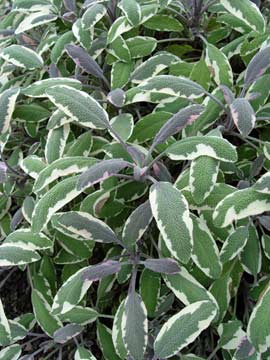 Tricolor sage has cream, purple and green leaves, making it as good looking as it is tasty.
Tricolor sage has cream, purple and green leaves, making it as good looking as it is tasty.
In the vegetable garden, most everything has to be replanted each season. Not so with that other main class of edibles – herbs. A majority of herbs are perennials throughout most of the United States. That means they come back year after year and usually get bigger or spread in territory each year. Some of our most-used cooking herbs are perennials, including sage, oregano and thyme. But a bonus of perennial herbs is that many of them are as attractive as they are tasty, making them functional beyond the kitchen.
Sage
Sage is a good example of a double-duty plant. Even the green-leafed type that’s usually sold for fresh harvesting has a neat, bushy habit that looks especially nice with spiky or frilly-leafed plants. Purple sage and tricolor sage (cream, purple and green leaves) make even more beautiful foliage partners for roses or any purple bloomer. Green-and-gold pineapple sage pairs well with bright-colored flowers such as black-eyed susans and golden daylilies, while ‘Berggarten’ sage has fuzzy grayish leaves that look a bit like lamb’s ears. All of the sages are drought-tough and bug- and disease-resistant, too.
Thyme and Oregano
Thyme and oregano are both perennial low-growers that make trouble-free groundcovers in any sunny part of the yard. Both also come in gold-leafed versions, and thyme is available in a silver-edged version as well. As with sage, thyme and oregano do well in dry sites – including particularly challenging spots along hot driveways, sidewalks and mailboxes.
Chives
Another easy-to-grow perennial herb is chives, an onion-family plant that sends up slender 16- to 18-inch-tall tubular stalks that produce walnut-sized purplish-pink flowers in spring. They’re attractive enough to go in a perennial garden, where you can snip the onion-flavored stalks as you need them to season potatoes or cheese dishes. Closely related is garlic chives, which also grow in spiky-leafed clusters – except the stalks are flat instead of tubular and the flowers are white and later to bloom (late summer). The stalk flavor is more garlic-flavored than oniony, too.
Mint
Then there’s the mint family. These come in a range of flavors (peppermint, spearmint, pineapple mint, chocolate mint, etc.), and they flower pinkish-white. A few have colorful white-edged foliage. Most often used to flavor tea, other beverages and desserts, mints are some of the most aggressive plants in the ground. That’s why they’re best planted in pots or hanging baskets, where they’re not only easy-to-harvest trailers but also well controlled away from the ground.
Clip back or dig and divide perennial herbs once or more a year to keep them the size you like. Most also get cut back to a few inches at the end of winter so each season’s growth is new and compact. A single springtime dose of a balanced granular fertilizer is usually plenty for perennial herbs. Their main enemy is wet clay soil, so don’t overdo it with water or plant them in soggy areas.